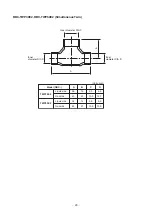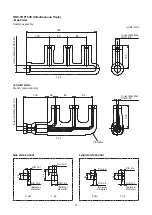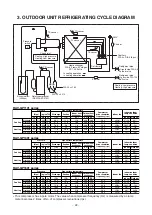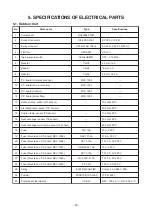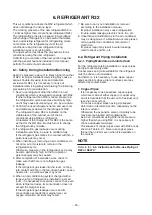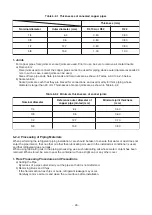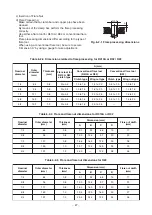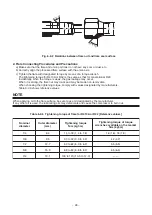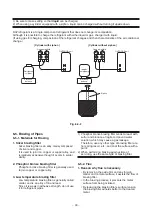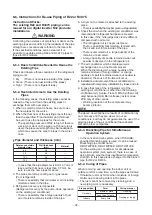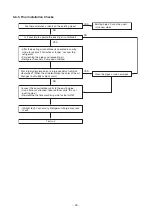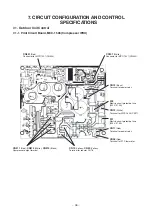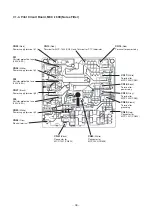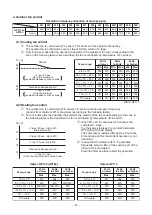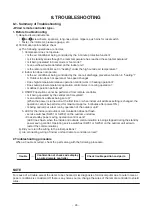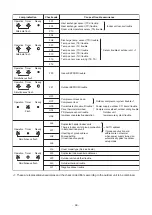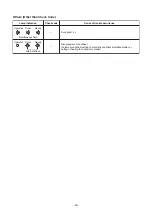
– 34 –
6-6-6. Handling of Existing Pipe
When using the existing pipe, carefully check it for
the following:
• Wall thickness (within the specified range)
• Scratches and dents
• Water, oil, dirt, or dust in the pipe
• Flare looseness and leakage from welds
• Deterioration of copper pipe and heat insulator
• Before recovering the refrigerant in the existing
system, perform a cooling operation for at least 30
minutes.
Cautions for using existing pipe
• Do not reuse a flare nut to prevent gas leaks.
Replace it with the supplied flare nut and then
process it to a flare.
• Blow nitrogen gas or use an appropriate means to
keep the inside of the pipe clean.
If discolored oil or much residue is discharged,
wash the pipe.
• Check welds, if any, on the pipe for gas leaks.
• There may be a problem with the pressure
resistance of the branch pipes of the existing
piping.
Replace them with branch pipes (sold separately).
When the pipe corresponds to any of the following,
do not use it. Install a new pipe instead.
• The pipe has been opened (disconnected from
indoor unit or outdoor unit) for a long period.
• The pipe has been connected to an outdoor unit
that does not use refrigerant R22, R410A, R32
R407C.
• The existing pipe must have a wall thickness equal
to or larger than the following thicknesses.
Reference out
s
ide
diameter (mm)
6.4
9
.5
12.7
15.
9
1
9
.1
22.2
2
8
.6
Wall thickne
ss
(mm)
0.
8
0.
8
0.
8
1.0
1.2
1.0
1.0
Material
—
—
—
—
—
H
a
lf h
a
rd
H
a
lf h
a
rd
• Do not use any pipe with a wall thickness less than
these thicknesses due to insufficient pressure
capacity.
6-6-7. Recovering Refrigerant
Use the refrigerant recovery equipment to recover the
refrigerant.
6-7. Charging additional refrigerant
Amount of additional refrigerant shall be restricted by
the following explanation to ensure the reliability.
Miss-charging leads to the abnormal high pressure in
the refrigerant cycle, causing a rupture, an injury and
a compressor malfunction.
6-7-1. [Assumed gas leak]
The refrigerant can be charged only when the
amount of a leak such as a slow-leak found at the
installation work can be ensured that it is within the
additional limits shown in the following.
Recharge the refrigerant if the amount of leakage is
unknown when you feel “Cooling is not working well”
or “Heating is not working well”.
6-7-2. [Limiting the additional charge]
• The maximum amount of additional refrigerant shall
be up to 10 % of the normal amount of the
refrigerant.
If no improvement in symptoms can be found at the
above limitation, recover all gases and recharge the
normal amount of refrigerant.
• If the slow leak is found at the installation work and
the connection pipe length is 15 m or less, tighten
the flare nut at the leak point and do not add the
refrigerant.
6-7-3. [Cautions on charging additional
refrigerant]
• When charging additional refrigerant, use a
balance with an accuracy of more than 10g scale.
Do not use a health-meter etc.
• If the refrigerant gas leaks, find the leakage point
and repair it securely. Though the refrigerant gas
itself is innocuous, if it touch a fire source such as
fan heater, stove or kitchen stove, noxious gas may
occur.
• When charging the refrigerant, charge with liquid
refrigerant.
Work carefully and charge it little by little since it
may be rapidly charged due to the liquid state.

